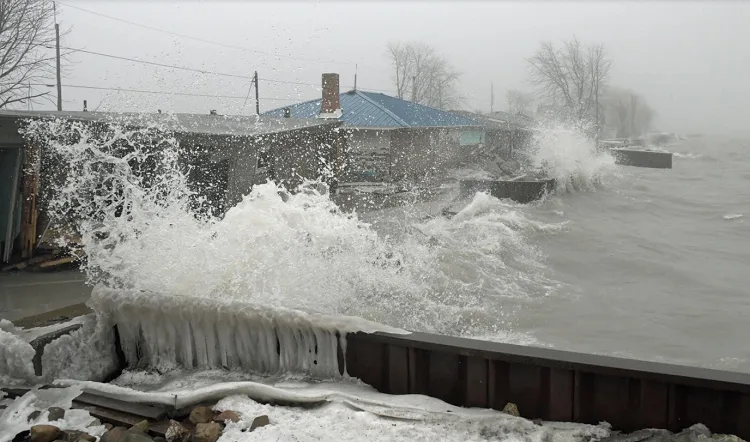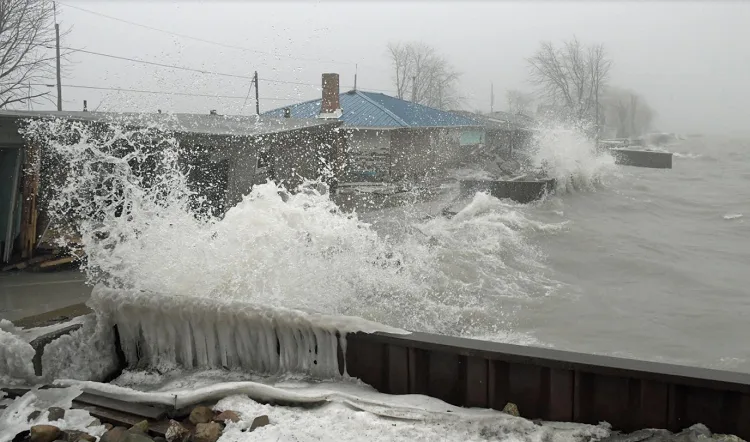
On Shaky Ground: Erie Shore Drive dike could fail
“There’s a time in life to walk away, but I’m not there yet.”
The ground feels perfectly solid below my feet. An unassuming road with gravel piled up carefully on the shoulders leads past a row of cheerful houses that face the waters of Lake Erie. The boom of waves impacting the seawalls came moments before the water swept across the roofs, sounding like the world’s largest teakettle boiling over. The day is cloudy and cold as a storm sweeps over southern Ontario; typical for this time of year.
But, unlike the familiar sky, the ground below me seems like any other. I’m standing on ground that carries a dark secret. Below me, in the heart of the gigantic dirt berm that protects farmland and homes near the southwestern tip of Ontario, near the town of Erieau, the lake it seeks to hold back is exposing an old weakness.
As I stand on the road looking down many metres to the rich farmland below, my imagination conjures up a worst-case scenario; the earth below my feet suddenly opening, water rushing into and through the breach, the Weather Network car and myself swept out into the farm fields kept dry by the massive dike. I shudder and turn my attention back to the task at hand; documenting the potential disaster that’s shaping up.
It’s not just my nightmare.
It’s a nightmare that is unfolding for all of those people involved with the dikes at the western end of Lake Erie, especially along a short stretch of road named Lake Erie Shore Drive near the town of Erieau.
My visit to Erie Shore Drive in early March 2020 wasn’t my first. I’d been there just before heading down to Florida to intercept a hurricane in the fall of 2019. When I arrived, the home of Frank Sparks was already being battered by waves but was weathering the storm fairly well. At the time, Frank was already concerned about the chances his home, which has been there since 1958, would survive.
“It’s not if the big winds hit, but when. This was my whole dream, my retirement, but now it's just a wait to assess the damage the storm has done. We just have to wait to board up the windows. Maybe it’s time the lake’s decided that it’s time to take back the property, but my goal is to salvage what I can. There’s a lot of mementos in the house that I want to get. I want to make sure I get my pictures of my son and me and my grandkids, that irreplaceable.”

Courtesy Mark Robinson.
He pauses and then says “There’s a time in life to walk away, but I’m not there yet.”
To understand why there’s now an ongoing emergency evacuation along the otherwise obscure bit of far southwestern Ontario, we need to go back to the late 1800s and look to a group of hardworking, motivated farmers that saw a massive swamp and realized the potential it had for farming. But, to go from swamp to tomatoes, a way to hold back the water of Lake Erie was needed.
And the best way to hold back water is to build a dam, or in this case, massive walls of dirt called berms.
Given that this was the late 1800s to early 1900s, the farmers had to use the materials at hand. The most prevalent materials were peat moss and clay dug right out of the swamp that they wanted to drain. Some of the earliest steam shovels were employed to rip huge trenches along the edge of the swamp and that material was dumped into massive berms that we can still walk, drive or live on today.
The dikes that rose out of the waters of the lake over 150 years ago looked as though they would last forever and once the dikes held back the lake waters were in place and the water pumped out of the now enclosed swamp, some of the richest farmland in North America emerged. The great dikes looked like nothing could ever breach their bulk, but unbeknownst to the farmers, in the center of each dike, a fatal weakness had been planted.
Walking down the slope of the dike, you might not notice the changes that have been wrought over the last 150 years, but if you know what you’re looking for, the signs are clear and the danger is alarming. I spoke to Tim Burnie from the Essex Region Conservation Authority about the dikes.
“When you get people building on the dikes or modifying, you start to affect the structural integrity of the dikes and, unfortunately right now, the lake level is 1.2 to 1.3 metres above the average lake level. That puts enormous wave pressure on the dikes – which were never armoured to withstand the wave action - and includes the downcutting of the berms below the waterline. As the material at the base of dike begins to erode and the slope of the surface of the dike gets over steep, you could have a landslide type failure that exposes the peat underneath the surface and the waves will begin to tear at the soft material. When a failure does occur, it will instantaneous. Water that floods through a small breach will begin to tear away at the sides and enlarge the break very quickly.”
Think of it as a tooth.
Once a cavity digs through the hard enamel of the surface, the soft dentine in the core can be attacked and destroyed quickly. And right now, cavities are riddling all the dikes that protect the huge swathes of farmland behind them in Chatham and Essex counties. It also protects homes and cottages that have been built on the top of the dikes since they were built.
This isn’t just a story about technical details of hydrology and climate. The unfolding disaster is upending lives.
In the present, as I stand atop the deteriorating berm, the situation has gotten worse and I once again find myself on the property of Tim Sparks, the homeowner I’d visited in the fall of 2019.
VIDEO: FUTURE OF LAKE ERIE AT THE MERCY OF MOTHER NATURE
The break wall that had been mostly intact is in shambles, and even small waves are piling water onto the property. The front of his home is now gone, smashed in by the unrelenting waves. Tim just happens to be there checking on the remains of his home and I take the chance to catch up with him.
“A lot of homes have been damaged severely, as you can see. I’m still holding on.
By a thread.
I was hoping to pass it on to my son. To my grandbabies, but that isn’t working out too well.”
His voice breaks, but he continues: “I just don’t know, I’m lost.Just like everybody else, I’m exhausted, I don’t know which way to go. North or south, I just don’t know. It’s a horrible thing to go through in your life. I just don’t know what to do.”
I needed to find out what could be done to help out Tim and his fellow residents, so I travelled into the nearby town of Chatham to talk to the mayor, Darrin Canniff.
He’s another person I’d talked to last fall and even then, he was very worried about the potential disaster that the crumbling dikes represent. Now, he’s gone beyond worried and decided to declare a state of emergency and an evacuation order for the residents of Erie Shore Drive.
“We’ve been dealing with the dike issue for a long time now,” Darrin tells me, “and we recently received a report from an engineer that the dikes have become more unstable. Based on that, given that safety is foremost, we’ve declared a state of emergency in order to go in and make repairs on it to ensure that it doesn’t breach.”
The mayor explains further: “We can go in and get things done. If we need to go on someone’s personal property to do repairs we can do that. It’s very urgent. We want to get this fixed in the next several weeks. The more we wait, the more probability there is of a breach.”
I’m left with the feeling that the township is doing all they can to deal with the problem, but is it enough? Will repairs be enough to deal with the battering waves that accompany the spring storms that impact southern Ontario?
Tim Burnie doesn’t think so.
“The last report we got there was some $6.5 million of work required for only one portion of the diking system. But, you can't very well build one side of a bathtub without undertaking the rest of the work," he says.
"So we’re now looking at up to $60 million just to bring it up to speed. Those dikes were never constructed in a fashion to sustain themselves against today’s lake levels.”
“All considerations need to go into place; is it sustainable, is it affordable, is it appropriate to have people living in those areas, where you can’t bring the dikes up to an appropriate standard, and who pays? It’s an unfortunate question that has to be asked and that answer is critical to it. You choose to live there, you gain the benefit, but if there’s no public benefit to you living there, who pays? Are you -- meaning the people there -- able to afford the millions of dollars needed to repair the dikes to an appropriate standard? Those tough questions need to be asked and then answered.”
Answering those questions standing far away from the lake seems easy to me. And I find myself wanting to say, it’s easy, get the people out and the problem goes away.
And yet, standing atop the dike in the midst of grim-faced homeowners, the emotion of losing their homes written in every movement they make to move treasured items from their homes to the squat, beige shipping containers that the township has provided, the answer isn’t so easy anymore.
The ground squelches under my feet as I walk to the edge of Frank’s property. He’s busy opening up the shipping container that’s now home to everything that used to be in his once-intact home. Friends are coming to help, but they won’t be here for another few hours.
He’s on his own for now. I stare out over the farmland that may soon be a part of Lake Erie and my mind once again goes back to the nightmare scenario of the ground opening, water sweeping everything aside. We can hold back the water, but for how long?
Spring storms are coming.










